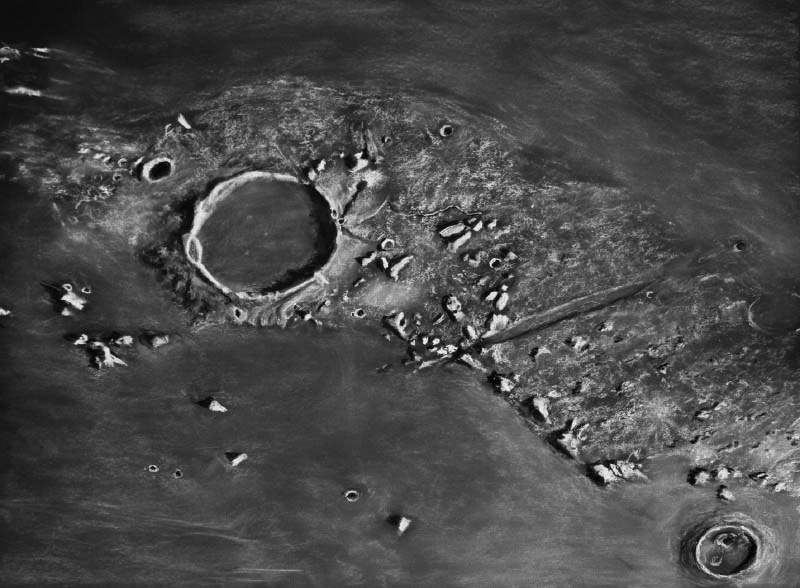June 27, 2009
Charcoal Excursion

image by Rich Handy, Jacumba, California
Surely the northeast rim of Mare Imbrium comprises some of the most magnificent, complex and recognizable set of features on the lunar surface. It is also witness to one of the most violent upheavals to have rocked the Moon, the creation of the enormous Imbrium Basin. The fury of this event, some 3.85 billion years ago, gouged and sculpted the arcing terrain of the rim into the familiar lineaments of mountainous ejecta and broken crater rims that radiate from the basin center. Stately Plato, whose somber, one hundred km wide floor lies flooded in basalt, was created several hundred thousand years after the basin was formed. Subsequent lava flooding during the next billion years nearly lead to it’s inundation. Venting from the glacis of the crater, long sinuous lava tubes channeled liquid magma down slope towards the shores of Mare Imbrium and Frigoris. A huge block of Plato’s western rim calved off and slid down toward the floor, perhaps after being undermined by the rising magma which embayed it’s floor-facing margins. Scattered about the mare to the southwest of Plato are the Montes Teneriffe. These peaks are 2.4 kilometers high and along with Mons Pico and Mons Piton, they are collectively known as Plato’s Sheep. It’s easy to imagine how impressive the appearance of these isolated mountains if viewed from the floor of Mare Imbrium. Uplifted plates of regolith rise along the eastern slopes of Plato’s glacis and line the north eastern shore of Mare Imbrium in a long, rugged, but graceful arc. These are the majestic Montes Alps, whose blocky peaks range 1,800 meters to 2,400 meters in altitude above the mare. Mons Blanc is even higher yet, nearly 3,500 meters in elevation. Halfway down the 250 km long mountain range is the famous Vallis Alpes or Alpine Valley. 180 km long and 10-20 km wide, the Alpine Valley does not appear to result from a gouge caused by ejecta from the Imbrium event, instead, it was created by radial stress fractures that were formed during the impact. The regolith above the fractures later collapsed to form the Valley. These same fractures probably formed the lava conduit for the rille that runs the Alpine Valley’s length. Following the arc of the Montes Alpes south past the Alpine Valley leads to 57 km Cassini whose glacis appears soft and pudding-like, the result of Mare Imbrium lavas encroaching on it’s wreath of ejecta.
Rich Handy
Technical Details
6-2-09; 4:57 to 8:53 UT. 12" Meade SCT f/10 + Binoviewer: Denkmeier BV-25 90 deg. W.O. erect image diagonal + Pentax XW 20mm eyepiece; magnification: 152X . Medium: Sketch White and black Conte' on Black 400 Strathmore Artagain paper.
Related Links
Rükl plates 3, 4, 11 & 12
Yesterday's LPOD: Mystery Image
Tomorrow's LPOD: Unpeeling History
COMMENTS?
Register, Log in, and join in the comments.



